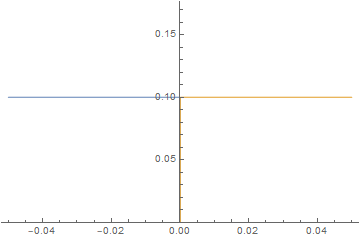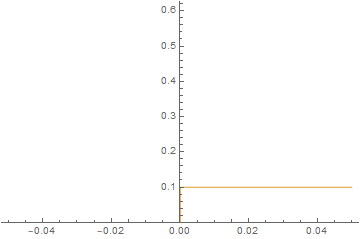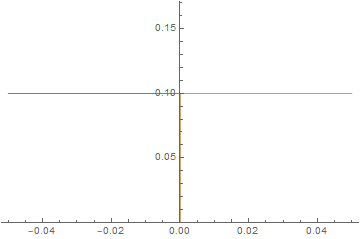Neumann boundary condition ignored
Mathematica Asked by Afmo on March 16, 2021
Im trying to solve a system of two PDE (im[t,x] and ia[t,x]) that are dependent on time and distance. I’m using my own anisotropic mesh (thanks to @TimLaska) that is aimed to represent an interface between a membrane and a liquid. The interface is located at L/2 where L = thickness of the system. “im” takes positive values in the interval 0 <= x <= L/2 and is equal to 0 at x > L/2. “ia” behaves similarly.
The problem that I’m encountering is that when I specify a Neumann boundary value at L/2, Mathematica doesn’t find this value in the mesh and the Neumann value is effectively ignored.
These are the functions for creating anisotropic meshes (kindly provided by @TimLaska in one of my previous questions)
(*Import required FEM package*)
Needs["NDSolve`FEM`"];
(*Define Some Helper Functions For Structured Meshes*)
pointsToMesh[data_] := MeshRegion[Transpose[{data}], Line@Table[{i, i + 1}, {i,Length[data]- 1}]];
unitMeshGrowth[n_, r_] := Table[(r^(j/(-1 + n)) - 1.)/(r - 1.), {j, 0, n - 1}]
meshGrowth[x0_, xf_, n_, r_] := (xf - x0) unitMeshGrowth[n, r] + x0
firstElmHeight[x0_, xf_, n_, r_] := Abs@First@Differences@meshGrowth[x0, xf, n, r]
lastElmHeight[x0_, xf_, n_, r_] := Abs@Last@Differences@meshGrowth[x0, xf, n, r]
findGrowthRate[x0_, xf_, n_, fElm_] := Quiet@Abs@ FindRoot[firstElmHeight[x0, xf, n, r] - fElm, {r, 1.0001, 100000},Method -> "Brent"][[1, 2]]
meshGrowthByElm[x0_, xf_, n_, fElm_] := N@Sort@Chop@meshGrowth[x0, xf, n, findGrowthRate[x0, xf, n, fElm]]
meshGrowthByElm0[len_, n_, fElm_] := meshGrowthByElm[0, len, n, fElm]
flipSegment[l_] := (#1 - #2) & @@ {First[#], #} &@Reverse[l];
leftSegmentGrowth[len_, n_, fElm_] := meshGrowthByElm0[len, n, fElm]
rightSegmentGrowth[len_, n_, fElm_] := Module[{seg}, seg = leftSegmentGrowth[len, n, fElm];
flipSegment[seg]]
extendMesh[mesh_, newmesh_] := Union[mesh, Max@mesh + newmesh]
Here I define a couple of constants and create my own mesh
(* Constants *)
L = 0.1; dim = dia = 1.*^-6; kf = kr = 1; kr =
1./kf;
imo[i_] := Piecewise[{{0.1, 0 <= i <= L/2.}, {0, i > L/2.}}]
iao[i_] := Piecewise[{{0, 0 <= i <= L/2.}, {0.1, i > L/2.}}]
(* Mesh generation *)
seg1 = rightSegmentGrowth[L/2., 100, L/1000];
seg2 = leftSegmentGrowth[L/2., 100, L/1000];
totalseg = extendMesh[seg1, seg2];
rh = pointsToMesh@totalseg ;
crd = MeshCoordinates[rh];
mesh = ToElementMesh[crd];
And here is the simple code I use to find the solution alongside the error I get
(*PDE system*)
eqsim = {D[im[t, x], t] - dim D[im[t, x], x, x] == NeumannValue[kf*ia[t, x], x == L/2.] + NeumannValue[0, x == L/2.],im[0, x] == imo[x]};
eqsia = {D[ia[t, x], t] - dia D[ia[t, x], x, x] == NeumannValue[kr*im[t, x], x == L/2.] + NeumannValue[0, x == L/2.], ia[0, x] == iao[x]};
sol = NDSolve[{eqsim, eqsia}, {im, ia},x [Element] mesh, {t, 0, 60}, Method ->{"MethodOfLines", "SpatialDiscretization" -> {"FiniteElement"}}]
(*NDSolve::bcnop: No places were found on the boundary where x==0.05 was True, so NeumannValue[ia,x==0.05] will effectively be ignored.*)
(*NDSolve::bcnop: No places were found on the boundary where x==0.05 was True, so NeumannValue[1. im,x==0.05] will effectively be ignored.*)
(* NDSolve::bcnop: No places were found on the boundary where x==0.05 was True, so NeumannValue[0,x==0.05] will effectively be ignored.*)
(*General::stop: Further output of NDSolve::bcnop will be suppressed during this calculation.*)
I first thought that the discretisation in the mesh didn’t include the point L/2 but after double checking I found out that it’s there
Position[crd, L/2.]
(*{{100, 1}}*)
Similar problems to this have been reported when using Dirichlet conditions here DiscretizeRegion does not include the boundary specified in ImplicitRegion (10.1)
, here PeriodicBoundaryConditions: missing points (a simpler example)
and here Solving Laplace’s equation in 2D using region primitives
, but after reading the solutions provided I haven’t been able to find a solution to my issue.
Any help, feedback or advice is more than welcome (I’m using v 12.2.0.0).
One Answer
Here's one way to solve the problem by explicitly modeling the interface region (note that this is explained in more detail here). We start 1st by defining some helper functions.
Mesh helper functions (edited)
These helper functions are similar to those described in the OP but have a couple of additions.
(*Import required FEM package*)
Needs["NDSolve`FEM`"];
(* Define Some Helper Functions For Structured Meshes*)
pointsToMesh[data_] :=
MeshRegion[Transpose[{data}],
Line@Table[{i, i + 1}, {i, Length[data] - 1}]];
unitMeshGrowth[n_, r_] :=
Table[(r^(j/(-1 + n)) - 1.)/(r - 1.), {j, 0, n - 1}]
meshGrowth[x0_, xf_, n_, r_] := (xf - x0) unitMeshGrowth[n, r] + x0
firstElmHeight[x0_, xf_, n_, r_] :=
Abs@First@Differences@meshGrowth[x0, xf, n, r]
lastElmHeight[x0_, xf_, n_, r_] :=
Abs@Last@Differences@meshGrowth[x0, xf, n, r]
findGrowthRate[x0_, xf_, n_, fElm_] :=
Quiet@Abs@
FindRoot[firstElmHeight[x0, xf, n, r] - fElm, {r, 1.0001, 1/fElm},
Method -> "Brent"][[1, 2]]
meshGrowthByElm[x0_, xf_, n_, fElm_] :=
N@Sort@Chop@meshGrowth[x0, xf, n, findGrowthRate[x0, xf, n, fElm]]
meshGrowthByElm0[len_, n_, fElm_] := meshGrowthByElm[0, len, n, fElm]
flipSegment[l_] := (#1 - #2) & @@ {First[#], #} &@Reverse[l];
leftSegmentGrowth[len_, n_, fElm_] := meshGrowthByElm0[len, n, fElm]
rightSegmentGrowth[len_, n_, fElm_] := Module[{seg},
seg = leftSegmentGrowth[len, n, fElm];
flipSegment[seg]
]
reflectRight[pts_] := With[{rt = ReflectionTransform[{1}, {Last@pts}]},
Union[pts, Flatten[rt /@ Partition[pts, 1]]]]
reflectLeft[pts_] :=
With[{rt = ReflectionTransform[{-1}, {First@pts}]},
Union[pts, Flatten[rt /@ Partition[pts, 1]]]]
extendMesh[mesh_, newmesh_] := Union[mesh, Max@mesh + newmesh]
Build 3 region mesh
The following workflow will build a 3 material region mesh representing the left side, a thin interface region, and the right side.
(*Constants*)
l = 0.1;
hl = l/2;
int = l/1000;
hint = int/2;
hlrem = hl - hint;
nhint = 5;
nhl = 100;
intelm = hint/nhint;
(*Build right-hand side of the mesh*)
hsegint = Subdivide[0, hint, nhint];
rint = pointsToMesh@hsegint
hseg = leftSegmentGrowth[hlrem, 100, intelm/10];
rhseg = pointsToMesh@hseg
(*Extend and reflect mesh about origin*)
r = pointsToMesh@reflectLeft@extendMesh[hsegint, hseg]
(* Extract Coords from RegionProduct *)
crd = MeshCoordinates[r];
(* grab line element incidents RegionProduct mesh *)
inc = Delete[0] /@ MeshCells[r, 1];
mesh = ToElementMesh["Coordinates" -> crd,
"MeshElements" -> {LineElement[inc]}];
(* Association for Clearer Region Assignment *)
reg = <|"left" -> 1, "int" -> 2, "right" -> 3|>;
(*Define regions for region marker function*)
Ωleft = ImplicitRegion[-hl <= x <= -hint, {x}];
Ωint = ImplicitRegion[-hint <= x <= hint, {x}];
Ωright = ImplicitRegion[hint <= x <= hl, {x}];
(* RegionMember Function *)
rmfl = RegionMember[Ωleft];
rmfi = RegionMember[Ωint];
rmfr = RegionMember[Ωright];
regmarkerfn =
Piecewise[{{reg["left"], rmfl[#1]}, {reg["int"], rmfi[#1]}},
reg["right"]] &;
(* Get mean coordinate of each hexa for region marker assignment *)
mean = Mean /@ GetElementCoordinates[mesh["Coordinates"], #] & /@
ElementIncidents[mesh["MeshElements"]] // First;
regmarkers = regmarkerfn /@ mean;
mesh = ToElementMesh["Coordinates" -> mesh["Coordinates"],
"MeshElements" -> {LineElement[inc, regmarkers]}];
Set up and solve PDE system
We will use the MassTransportPDEComponentto create a PDE operator that depends on region dependent coefficients as shown below:
(*Mass transport parameters*)
dl = 10^-6;
dr = 10^-6;
kf = 0.1; kr = 1/8 kf;
K = kf/kr;
k0 = 10^4;
(*Initial condition function*)
imo[i_] := Piecewise[{{0.1, i <= -hint}, {0, i > hint}}]
iao[i_] := Piecewise[{{0, i < hint}, {0.1, i >= hint}}]
(*Define switch to activate reactions in membrane region*)
sigma = Evaluate[
Piecewise[{{1, ElementMarker == reg["int"]}, {0, True}}]];
(*Defined region dependent diffusion coefficients*)
diffleft =
If[ElementMarker == reg["left"] || ElementMarker == reg["int"], dl,
0];
diffright =
If[ElementMarker == reg["right"] || ElementMarker == reg["int"],
dr, 0];;
(*PDE system*)
op = MassTransportPDEComponent[{{im[t, x], ia[t, x]}, t, {x}}, <|
"DiffusionCoefficient" -> {{diffleft, 0}, {0, diffright}},
"MassReactionRate" -> {{-sigma k0 (K ia[t, x] - im[t, x])/
im[t, x], 0}, {0,
sigma k0 (K ia[t, x] - im[t, x])/ia[t, x]}}|>];
eqns = op == {0, 0};
{imFun, iaFun} =
NDSolveValue[{eqns, im[0, x] == imo[x], ia[0, x] == iao[x]}, {im,
ia}, x ∈ mesh, {t, 0, 60}];
imgs = Plot[{imFun[#, x], iaFun[#, x]}, x ∈ mesh,
PlotPoints -> 500,
PlotRange -> {0, Max@imFun["ValuesOnGrid"]}] & /@
Subdivide[0, 60, 60];
ListAnimate@imgs
It is straightforward to change parameters and initial conditions and estimate their effect on the solution. Here, we will initialize the left-hand side at 0 concentration and give the right-hand side a much higher diffusion coefficient similar to a gas and watch the system evolve.
(*Mass transport parameters*)
dl = 10^-6;
dr = 10^-3;
kf = 0.1; kr = 1/8 kf;
K = kf/kr;
k0 = 10^4;
(*Defined region dependent diffusion coefficients*)
diffleft =
If[ElementMarker == reg["left"] || ElementMarker == reg["int"], dl,
0];
diffright =
If[ElementMarker == reg["right"] || ElementMarker == reg["int"], dr,
0];
(*Initial condition function*)
imo[i_] := Piecewise[{{0, i <= -hint}, {0, i > hint}}]
iao[i_] := Piecewise[{{0, i < hint}, {0.1, i >= hint}}]
op = MassTransportPDEComponent[{{im[t, x], ia[t, x]}, t, {x}}, <|
"DiffusionCoefficient" -> {{diffleft, 0}, {0, diffright}},
"MassReactionRate" -> {{-sigma k0 (K ia[t, x] - im[t, x])/
im[t, x], 0}, {0,
sigma k0 (K ia[t, x] - im[t, x])/ia[t, x]}}|>];
eqns = op == {0, 0};
{imFun, iaFun} =
NDSolveValue[{eqns, im[0, x] == imo[x], ia[0, x] == iao[x]}, {im,
ia}, x ∈ mesh, {t, 0, 60}];
imgs = Plot[{imFun[#, x], iaFun[#, x]}, x ∈ mesh,
PlotPoints -> 500,
PlotRange -> {0, Max@imFun["ValuesOnGrid"]}] & /@
Subdivide[0, 60, 60];
ListAnimate@imgs
Modeling very thin membranes
@Afmo had a question in the comments about the numerical stability of modeling a 1 nm membrane on a 1 cm domain (a 7 order of magnitude difference). Now, if you're not interested in what happens within the membrane material and just want to use it as a means to model the jump condition, the membrane does not need to be 1 nm. One can simply merge the 2 fluid domains as a postprocessing step and ignore the membrane itself. However, in this case, the anisotropic meshing procedure still appears to be numerically stable over a 7 order magnitude ratio of domain size to membrane size as shown in the following workflow.
Very thin membrane mesh
To maintain numerical stability, it is generally a good practice to at least match the element thickness at the interface. An example is shown with the following workflow (please note that I adjusted the mesh helper functions to accommodate these huge aspect ratio differences):
(*Constants*)
l = 0.1;
hl = l/2;
(*7 order magnitude difference between membrane thickness and domain
size*)
int = l/10000000;
hint = int/2;
hlrem = hl - hint;
nhint = 1;
nhl = 100;
intelm = hint/nhint;
(*Build right-hand side of the mesh*)
hsegint = Subdivide[0, hint, nhint];
rint = pointsToMesh@hsegint
hseg = leftSegmentGrowth[hlrem, nhl, intelm];
rhseg = pointsToMesh@hseg
(*Extend and reflect mesh about origin*)
r = pointsToMesh@reflectLeft@extendMesh[hsegint, hseg]
(* Extract Coords from RegionProduct *)
crd = MeshCoordinates[r];
(* grab line element incidents RegionProduct mesh *)
inc = Delete[0] /@ MeshCells[r, 1];
mesh = ToElementMesh["Coordinates" -> crd,
"MeshElements" -> {LineElement[inc]}];
(* Association for Clearer Region Assignment *)
reg = <|"left" -> 1, "int" -> 2, "right" -> 3|>;
(*Define regions for region marker function*)
Ωleft = ImplicitRegion[-hl <= x <= -hint, {x}];
Ωint = ImplicitRegion[-hint <= x <= hint, {x}];
Ωright = ImplicitRegion[hint <= x <= hl, {x}];
(* RegionMember Function *)
rmfl = RegionMember[Ωleft];
rmfi = RegionMember[Ωint];
rmfr = RegionMember[Ωright];
regmarkerfn =
Piecewise[{{reg["left"], rmfl[#1]}, {reg["int"], rmfi[#1]}},
reg["right"]] &;
(* Get mean coordinate of each hexa for region marker assignment *)
mean = Mean /@ GetElementCoordinates[mesh["Coordinates"], #] & /@
ElementIncidents[mesh["MeshElements"]] // First;
regmarkers = regmarkerfn /@ mean;
mesh = ToElementMesh["Coordinates" -> mesh["Coordinates"],
"MeshElements" -> {LineElement[inc, regmarkers]}];
Set up and solve PDE system
Set up and solve the PDE system as before:
(*Mass transport parameters*)
dl = 10^-6;
dr = 10^-6;
kf = 0.1; kr = 1/8 kf;
K = kf/kr;
k0 = 10^4;
(*Initial condition function*)
imo[i_] := Piecewise[{{0.1, i <= -hint}, {0, i > hint}}]
iao[i_] := Piecewise[{{0, i < hint}, {0.1, i >= hint}}]
(*Define switch to activate reactions in membrane region*)
sigma = Evaluate[
Piecewise[{{1, ElementMarker == reg["int"]}, {0, True}}]];
(*Defined region dependent diffusion coefficients*)
diffleft =
If[ElementMarker == reg["left"] || ElementMarker == reg["int"], dl,
0];
diffright =
If[ElementMarker == reg["right"] || ElementMarker == reg["int"],
dr, 0];;
(*PDE system*)
op = MassTransportPDEComponent[{{im[t, x], ia[t, x]}, t, {x}}, <|
"DiffusionCoefficient" -> {{diffleft, 0}, {0, diffright}},
"MassReactionRate" -> {{-sigma k0 (K ia[t, x] - im[t, x])/
im[t, x], 0}, {0,
sigma k0 (K ia[t, x] - im[t, x])/ia[t, x]}}|>];
eqns = op == {0, 0};
{imFun, iaFun} =
NDSolveValue[{eqns, im[0, x] == imo[x], ia[0, x] == iao[x]}, {im,
ia}, x ∈ mesh, {t, 0, 60},
StartingStepSize -> 0.000000001];
imgs = Plot[{imFun[#, x], iaFun[#, x]}, x ∈ mesh,
PlotPoints -> 500,
PlotRange -> {0, Max@imFun["ValuesOnGrid"]}] & /@
Subdivide[0, 60, 60];
ListAnimate@imgs
Obviously, one will ultimately reach a limit, but we been able to extend the anisotropic meshing to an impressive 7 order magnitude difference without evidence of great numerical instability.
Correct answer by Tim Laska on March 16, 2021
Add your own answers!
Ask a Question
Get help from others!
Recent Answers
- Joshua Engel on Why fry rice before boiling?
- Jon Church on Why fry rice before boiling?
- Lex on Does Google Analytics track 404 page responses as valid page views?
- Peter Machado on Why fry rice before boiling?
- haakon.io on Why fry rice before boiling?
Recent Questions
- How can I transform graph image into a tikzpicture LaTeX code?
- How Do I Get The Ifruit App Off Of Gta 5 / Grand Theft Auto 5
- Iv’e designed a space elevator using a series of lasers. do you know anybody i could submit the designs too that could manufacture the concept and put it to use
- Need help finding a book. Female OP protagonist, magic
- Why is the WWF pending games (“Your turn”) area replaced w/ a column of “Bonus & Reward”gift boxes?


